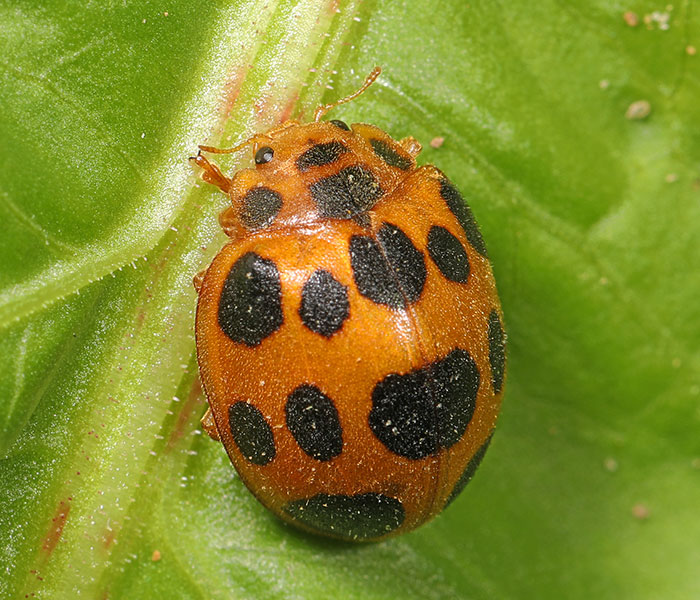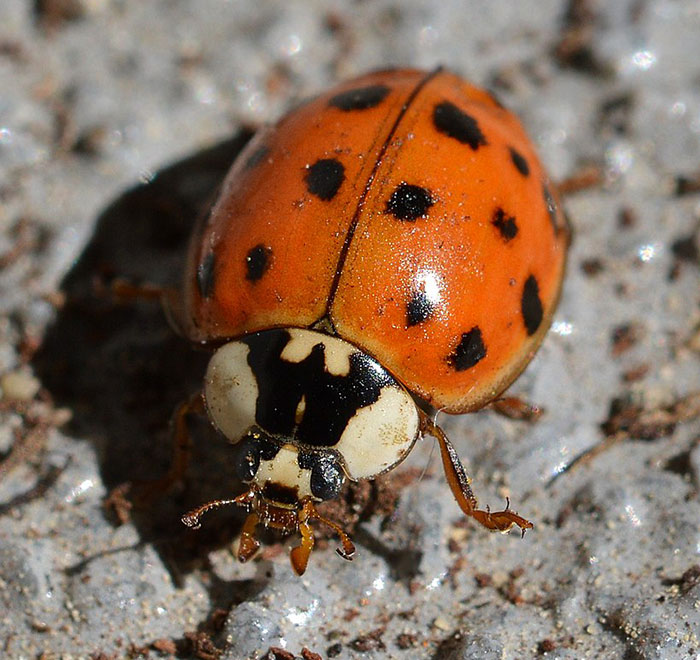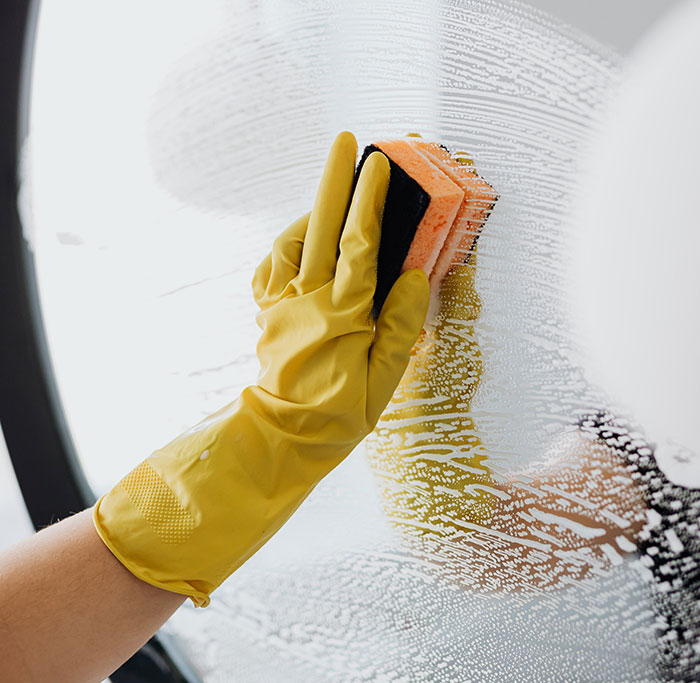Everything You Need to Know About Yellow Ladybug
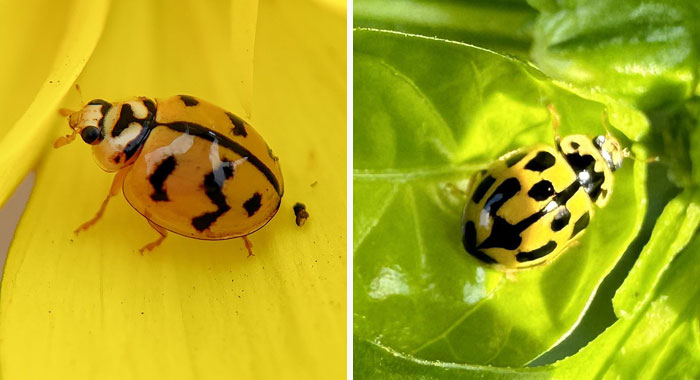
We all know the classic ladybug look—bright red shell, little black spots, and that tiny head that makes them kind of cute. Most of the time, spotting them in your backyard is actually a good sign for your garden health. A moderate number of ladybugs usually means your plants are thriving and your natural pest control system is working just fine.
But every now and then, you might come across something different—a yellow ladybug. Yep, it’s still a ladybug, but with a yellow body instead of red. Now, here’s the thing: sometimes it’s harmless and other times it can signal a problem, especially when you’re dealing with the more notorious Asian lady beetle infestation, which we’ll get into in just a bit.
The good news? In most cases, a yellow ladybug isn’t something you need to panic about. They’re not automatically a threat to your garden, your home, or your lawn care routine. Still, if you’re serious about organic gardening and pest management, it’s worth paying attention to the color variations and knowing when to call in professional pest control services if things get out of hand.
What Does a Yellow Ladybug Mean?
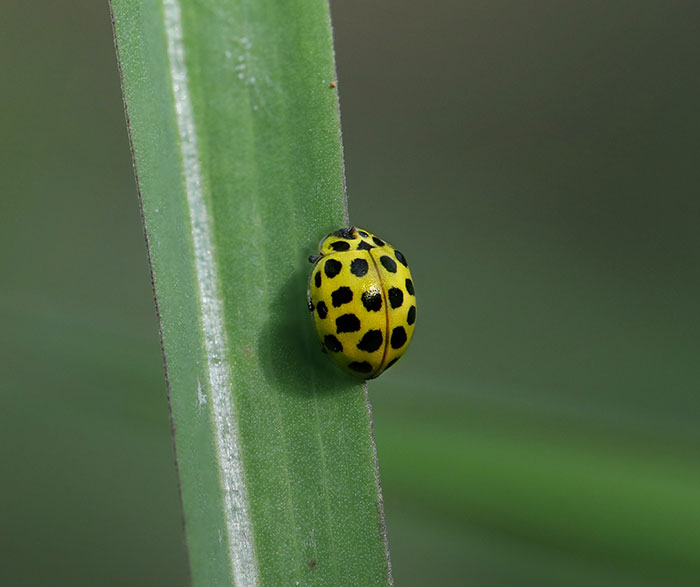
Image credit: Erik Karits
Before you go trying to scoop up every ladybug you spot, it helps to know the spiritual meaning and cultural symbolism behind these little beetles—especially the yellow ones. Traditionally, ladybugs have always been seen as a good luck charm, often tied to happiness, success, and fresh starts. Think of them as tiny messengers of positivity and personal growth.
But here’s where it gets interesting: different cultures interpret the yellow ladybug meaning in their own unique way. For example, in Australia, people believe that crossing paths with one of these golden bugs can attract good fortune and prosperity. In some other traditions, when a yellow ladybug lands on you, it’s seen as a sign that financial gains, wealth manifestation, or new opportunities for financial freedom are headed your way.
Whether you’re into money attraction rituals, prosperity symbols, or just enjoy the fun folklore, one thing’s clear—the yellow ladybug carries way more than just a pop of color.
Why Are They Yellow?

Image credit: Shyamli Kashyap
Alright, time to pull out the biology notebook (don’t worry, no boring lecture vibes here). A ladybug goes through a four-stage life cycle—it kicks off as tiny eggs, then turns into larva, later develops into pupa, and finally becomes the colorful ladybug we all recognize. The cool part? That yellow shade usually shows up somewhere between the third and fourth stages, and once the ladybug fully emerges, the color gets bolder and brighter.
Now, here’s where pest control and garden protection come into play. That bright yellow (or even red) isn’t just for looks—it’s basically a natural insect repellent signal to predators. In nature, strong colors usually scream “poison” or “danger,” so a lot of predators steer clear. Still, some creatures like birds, spiders, and even wasps don’t always get the memo and will go after them.
The funny thing is, even though the yellow ladybug looks kinda intimidating, it’s not harmful to your garden or your health. In fact, they’re a big part of eco-friendly gardening tips and biological pest management strategies since they munch on plant-eating pests.
Which brings us to the big question…
Are Yellow Ladybugs Harmless?
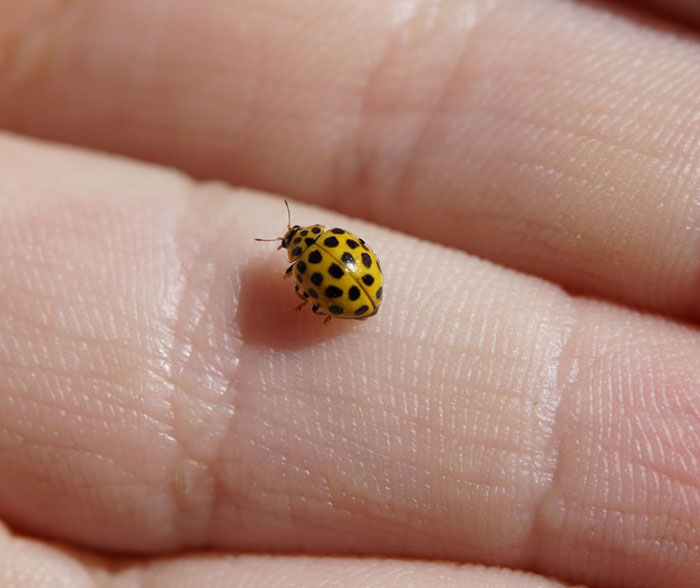
Image credit: pxhere.com
So here’s the deal—yellow ladybugs aren’t poisonous to humans (though, yeah, probably don’t snack on them). They’re not apex predators either, so they won’t go around hunting everything in your garden. But here’s where you gotta be careful: the Asian lady beetle (Harmonia axyridis). This species can actually be risky for pet safety. If a dog swallows one, it can irritate their stomach and, in really bad cases, even lead to serious health problems or worse.
On top of that, ladybugs do bite. A yellow ladybug bite might not be deadly, but it feels like a sharp little pinch and can trigger an allergic skin reaction for some people. If that happens, you’ll want to look into basic home remedies for bug bites or even proper allergic skin reaction treatment if it gets worse. For pets, especially dogs, if you notice signs like vomiting, drooling, or refusing food, don’t wait—emergency vet care is the best move.
At the end of the day, most yellow ladybugs are harmless and even help with natural pest control in gardens, but it’s still good to know the risks when it comes to dog health and keeping your home safe.
Yellow Ladybug Types
Ladybugs come in all kinds of shapes, patterns, and wild colors. You’ll spot everything from the classic red ones to yellow and black ladybugs, each carrying its own vibe. Some of them are totally fine and even fall under the category of beneficial insects because they keep your garden free from pests. Others? Not so much—they can actually turn into a mini nightmare for your plants if you don’t keep an eye on them.
That’s why a little pest identification goes a long way. Knowing which species is chilling in your backyard helps you decide whether to let them do their thing for natural pest control or call in some garden pest management strategies. And hey, if you’re into organic gardening tips or want to save money on lawn care services, learning about the different varieties of ladybugs can seriously help you out.
So yeah, yellow and black ladybugs might look cute, but depending on the type, they could either be your garden’s BFF or the start of an annoying insect infestation.
22-spotted Yellow Ladybug
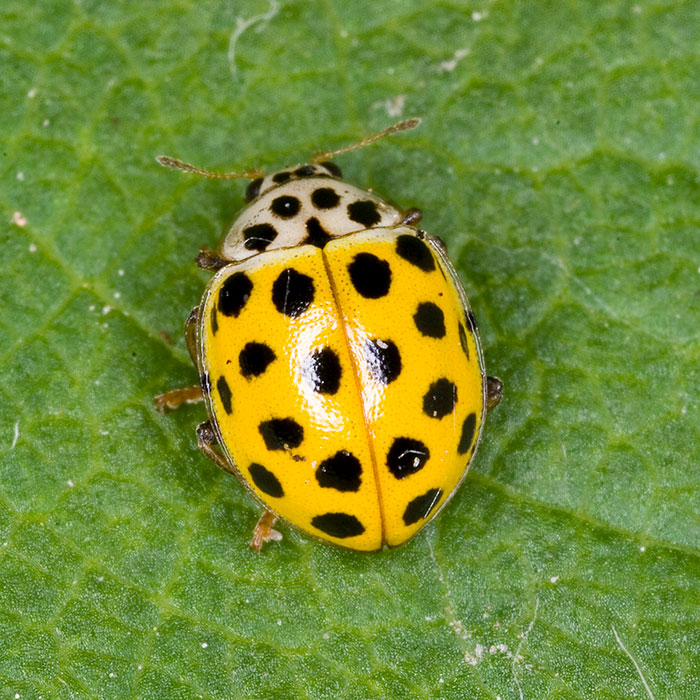
Image credit: Olei, CC BY-SA 3.0 DEED
Scientific name: Psyllobora vigintiduopunctata.
About: This little guy is native to North America, Europe, and even parts of Asia, and it’s super easy to recognize because of the 22 black spots on its body (yep, that’s where the name comes from). Gardeners actually love spotting this variety since it often falls into the category of beneficial insects that help with natural pest control.
If you’re into organic farming or just want some budget-friendly lawn care tips, keeping track of species like this can make a big difference. Proper garden insect identification lets you know when to let nature do its work and when it’s time to call in professional pest control services.
So, next time you see this spotted beetle chilling in your garden, don’t panic—it’s usually a sign that your backyard ecosystem is working exactly the way it should.
Toxicity: Not considered poisonous to humans or animals.
Squash Lady Beetle
Image credit: Judy Gallagher, CC BY 2.0 DEED
Scientific name: Epilachna borealis.
About: Some farmers don’t think twice before squashing this ladybug, and honestly, they’ve got their reasons. This little pest, better known as the Squash Lady Beetle, loves feeding on squash plants, pumpkins, cucumbers, and other related crops. The real trouble starts with the larvae—they can completely wreck your garden by chewing up leaves until there’s nothing left but the skeleton.
If you’re serious about crop protection or running a small organic farm, spotting and identifying this beetle early is key. It’s easy to recognize thanks to those big black spots on its body, making garden pest identification a whole lot easier.
Instead of reaching straight for chemicals, many growers look into organic pest control solutions or even professional agricultural pest control services to minimize damage while keeping plants safe. Either way, this isn’t the kind of visitor you want hanging around your crops.
Toxicity: While it can cause damage to plants, it’s not typically considered toxic to humans or animals.
Convergent Lady Beetle
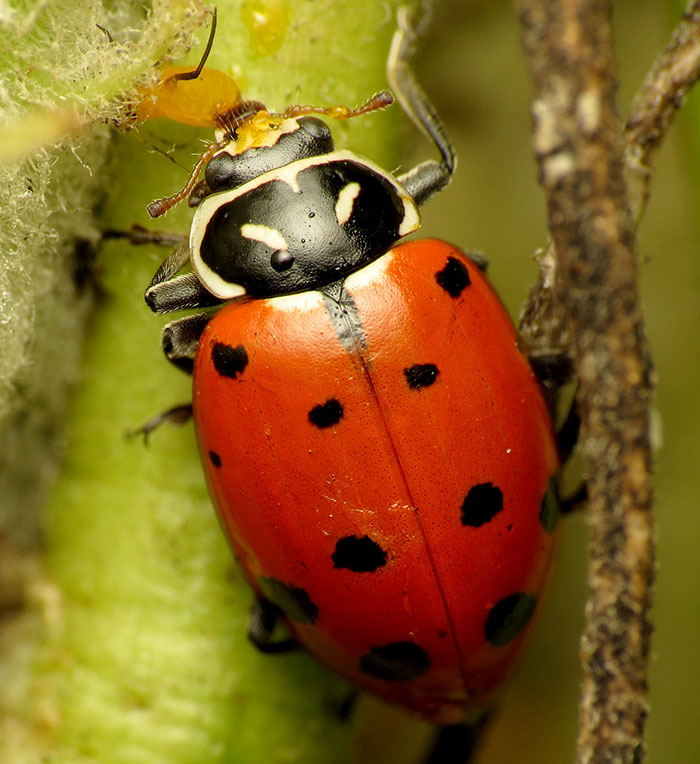
Image credit: Katja Schulz, CC BY 2.0 DEED
Scientific name: Hippodamia convergens.
About: Native to North America, these beetles are used as a biological control tool for aphids. They can have yellowish to reddish bodies.
Toxicity: Not considered toxic to humans or pets.
Asian Lady Beetle
Image credit: Ryan Hodnett, CC BY-SA 4.0 DEED
Scientific name: Harmonia axyridis.
About: Yellow, red, or somewhere in between, the Asian lady beetle (also called the multicolored lady beetle) comes in all sorts of shades. At first glance, they might look kind of cute, but if you’re into gardening you probably already know the truth—these guys are a real garden pest. They invade homes, bite, and can even trigger allergic reactions in some people. That’s why most experts recommend getting rid of them quickly using safe methods like organic pest control sprays or even calling in professional pest control services if things get out of hand.
Toxicity: Can be potentially harmful to pets.
How to Identify an Asian Lady Beetle?
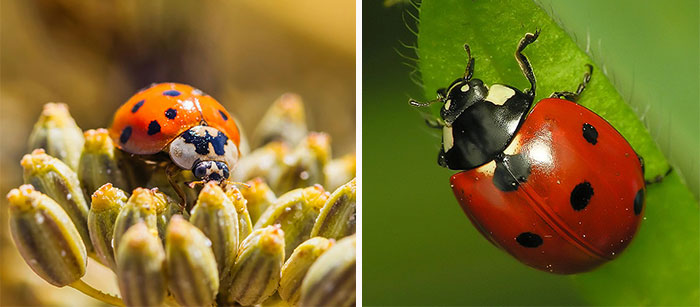
Image credit: Robert So, Dominik Stodulski, CC BY-SA 3.0 DEED
Knowing when you have a problem can make a big difference to your home and garden. The problems with Asian lady beetles can get out of hand fast. One day you see a few crawling around, and before you know it, your house and garden feel like a full-on pest infestation. These beetles aren’t just annoying—they can actually be harmful. They’ve been known to irritate dogs and cats, leave nasty odors and stains on walls and furniture, and even trigger allergic reactions in some people. And the biggest issue? They can absolutely wreck your garden plants if you don’t take action with the right pest control treatment.
Here’s where things get tricky—identifying them. Spotting the difference between a harmless yellow ladybug (great for your garden’s natural pest control) and the invasive multicolored Asian lady beetle can save you a ton of stress. The Asian beetles usually look bigger, more oval-shaped, and they’ve got that little “M” pattern on their heads. They also tend to lean more yellow-orange than that classic bright red.
Behavior-wise, they make themselves obvious. During winter, they sneak into houses looking for shelter. And it’s never just one—you’ll usually find a whole swarm of them. Then, when spring hits, they head back outside and start munching away at your plants. That’s why many homeowners turn to professional pest control services or eco-friendly pest management solutions before things spiral out of control.
How to Get Rid of Asian Lady Beetles for Good?
Image credit: Karolina Grabowska
So, can you already spot the difference between the harmless ladybugs and the invasive ones? Good—because now comes the not-so-fun part: actually dealing with an infestation. The sooner you take action, the easier it is to protect your home and garden. Depending on whether it’s indoors or outdoors, the way you tackle the problem will be different.
Indoors, the process is usually simple. The safest home pest control method is just to grab a vacuum and suck them up. Once you’ve collected them, seal them tight in a plastic bag—you don’t want these pests crawling back out. Avoid harsh chemicals or sprays inside your house. Not only are they risky for your health, but dead beetles stuck in walls or corners can attract other household pests like ants or roaches.
If you want to avoid the headache altogether, go for pest prevention tips like sealing cracks near doors and windows, fixing tiny gaps, and washing surfaces with plain soap and water. It sounds too simple to work, but trust me, it’s one of the most effective natural pest removal methods out there.
For outdoor infestations, you don’t really need pricey tools or toxic sprays. A broom, a hose, and a little soap do wonders. Sweep or spray them away, then scrub the surfaces with soapy water. Keep checking the area every few days and repeat the process until the Asian lady beetles stop showing up.
No matter where you’re dealing with them, just don’t crush them. The fluid they release can stain furniture, leave behind a horrible odor, and honestly make the problem worse. Bottom line? Learn the difference between the “good” ladybugs that help your garden and the invasive ones that cause pest infestations—and if things ever get too overwhelming, don’t hesitate to call in a professional pest control service or licensed exterminator near you.
Yellow Ladybug is No Enemy
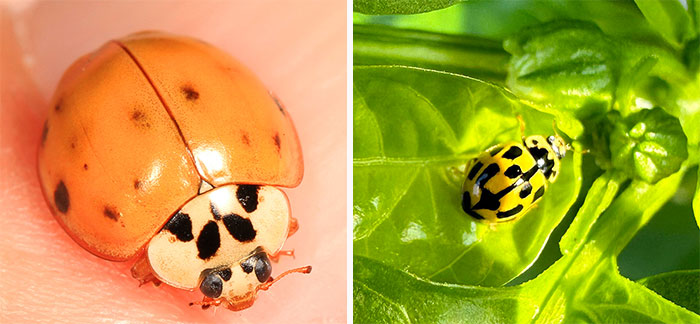
Image credit: Judy Gallagher, CC BY 2.0 DEED, hughmcg1974ADVERTISEMENT
Now that you’ve got the scoop on different types of ladybugs and how to deal with the unwanted ones, you can finally relax a little. Don’t stress too much if you spot the occasional yellow ladybug hanging around your garden—they’re usually a good sign and actually help with natural pest control.
But here’s the catch: if you start noticing larger, oval-shaped bugs that lean more yellowish-red and have that telltale “M” marking on their heads, that’s when you should step in. These are invasive Asian lady beetles, and they’re not the kind of “garden helpers” you want. Grab your broom, a little soap, and water, and handle it before they take over.
At the end of the day, most ladybugs are beneficial and mean your plants are thriving, but knowing how to identify the bad ones can save you from bigger pest infestation problems down the road. And if it ever feels like too much to handle, consider reaching out to a professional eco-friendly pest control service or exploring organic pest management solutions that keep your garden safe without harsh chemicals.
FAQ
How Long Do Yellow Ladybugs Live?
Did you know ladybugs can actually live up to a year once they reach their adult stage? Pretty cool, right? But here’s the wild part—their entire ladybug life cycle (egg → larva → pupa → adult) can stretch out to almost two years depending on the climate and environment. For gardeners, understanding the insect life cycle isn’t just fun trivia, it’s also super useful when it comes to garden pest management.
Because here’s the thing—while most ladybugs are beneficial for organic gardening, some invasive species can turn into a headache if you’re not careful. Knowing how long they stick around can help you decide whether to rely on natural pest control methods or call in professional pest control services if things get out of hand.
What Do Yellow Ladybugs Eat?
Most people don’t realize it, but ladybugs are basically tiny pest-control machines. The majority of their diet is made up of annoying little garden invaders—especially aphids. In fact, that’s one of the main reasons certain types of ladybugs were actually introduced in different regions: natural aphid control. But they don’t stop there—ladybugs happily munch on mites, mealybugs, and other soft-bodied pests that can destroy your plants.
So if you’re into organic gardening or just want some eco-friendly pest solutions without loading your backyard with chemicals, attracting more ladybugs can be one of the easiest tricks for garden pest management.
What Are Some Interesting Facts About Yellow Ladybugs?
Even though they’re tiny, ladybugs are honestly pretty fascinating. Yeah, we’ve mentioned the downsides of some invasive types (like the Asian lady beetle), but overall, most ladybugs are super beneficial because they help with natural pest control by keeping populations of aphids and other destructive bugs in check. That’s why gardeners love them as part of eco-friendly pest management instead of using harsh chemicals.
On top of that, ladybugs aren’t just about saving your plants—they’ve also been tied to luck, protection, and good fortune for centuries. In a lot of cultures, spotting a ladybug is seen as a symbol of good luck or even a sign that positive change is coming your way. So whether you’re looking at them as part of your natural garden solutions or just as a lucky charm, ladybugs have a pretty sweet reputation.

